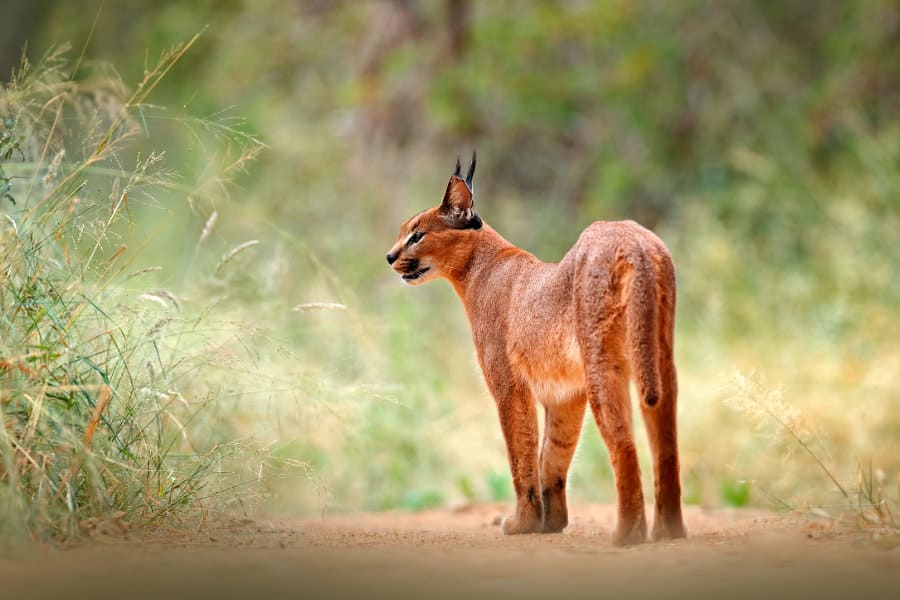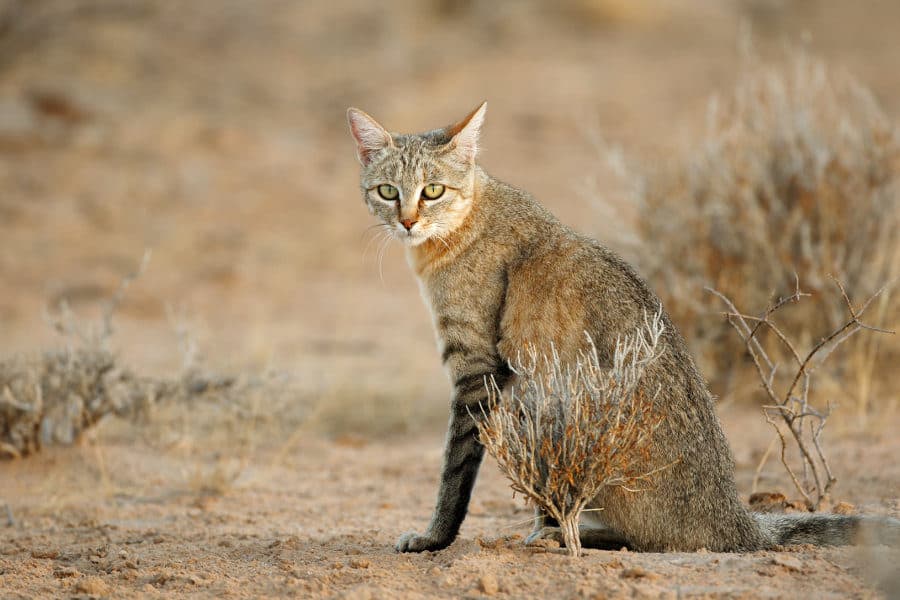Caracal vs serval.
This matchup may be more obscure than lion vs tiger, or cheetah vs leopard, but these wonderful wild cats deserve some appreciation.
Many people’s dream safari likely involves spotting a pride of lions prowling the savanna, a leopard lounging in a tree, or a cheetah chasing a gazelle.
Yet there are several other species of wild cats in Africa. These include the serval and the caracal, two closely related, medium-sized African cats.
Caracals and servals may not measure up size-wise against their bigger relatives, but they’re just as agile, graceful, and beautiful as any of their fellow felines.
Read on for a comprehensive caracal vs serval comparison, and discover the differences between these two striking species.
Caracal vs Serval Size & Appearance
Caracals and servals are similar in size and body shape. They’re slender, with long legs and large ears.
Servals are taller, reaching over 60 cm at the shoulder, while caracals measure up to 50 cm tall.
Caracals are more sturdily built and have a slightly longer body length of 78-108 cm, compared to the serval’s 67-100 cm.
There’s a large weight overlap, though the largest male caracals tip the scales at 19 kg, while servals weigh up to 18 kg.
That puts both species midway up the cat size scale – well below the big cats, but fairly hefty compared to your neighbourhood tabby.
Telling the difference between caracals and servals
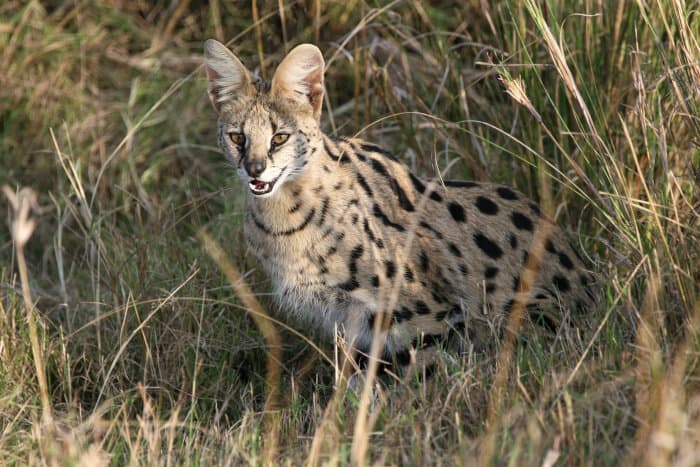
How do you know whether you’re looking at a serval vs a caracal, then? The easiest way to tell them apart is by their fur.
Caracals have a uniformly reddish-brown fur with white underside, chin, and throat.
Servals, on the other hand, have a golden yellow coat with black spots and stripes.
If you’re still unsure (after all, these stealthy species might be skulking in the long grass), take a look at the top of their heads.
Both cats have prominent ears, but the caracal’s are more distinctive, with black tufts protruding from the top.
The caracal’s pointy ears are the ‘purrfect’ predatory adaptation, acting like antennas that pick up the slightest sound.
Caracal vs Serval Distribution
Serval cats are relatively widespread in the Sahel, East Africa, West Africa, and Southern Africa, with only small, fragmented populations in North Africa. They live in a variety of habitats, from semi-arid areas to woodland, wetland, and savannas.
Caracals are widely distributed throughout Sub-Saharan Africa, apart from the rainforests of Central Africa. There’s also a small population in North Africa.
Unlike the serval, caracals also live in parts of Asia, including the Arabian Peninsula, Middle East, and as far east as India.
Caracal cats are highly adaptable, living in forests, savannas, marshes, and semi-desert areas. They prefer dry areas with cover, to help them sneak up on prey or avoid detection.
Servals also prefer areas with plenty of cover – reeds and tall grasses that grow near water sources are ideal.
Serval vs Caracal Diet
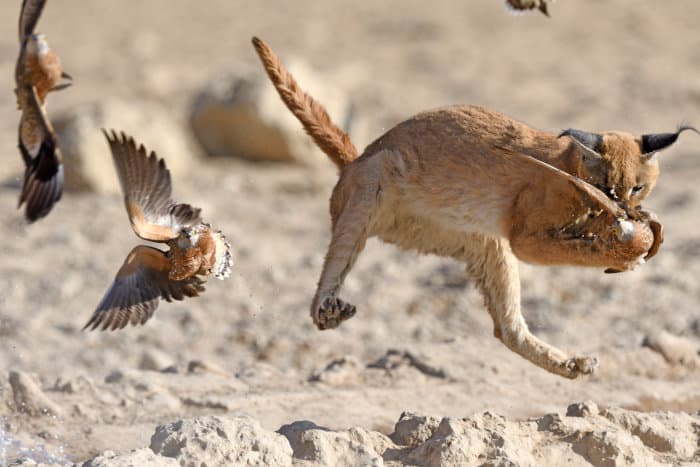
What do caracals eat? Like any cat, the answer is meat, and lots of it.
They’ll take rodents, reptiles, and birds, as well as slightly larger mammals like hares, hyraxes, and several antelope species.
Servals are similarly carnivorous, though they’re more of a rodent specialist. Rats, mice, and other small mammals are their favourite prey.
Serval cats also eat reptiles, insects, birds, and occasionally small antelope.
Both species are adept ambush hunters, silently stalking their prey until close enough to launch a rapid attack. They often pounce on small prey, while larger animals may require a short pursuit.
Servals have a success rate that puts big cats to shame – half of all hunts end in a kill!
Behaviour
Caracals and servals are solitary and secretive animals. Caracal cats are largely nocturnal, whereas servals are active both day and night – although the two species are less active in bright sunlight.
Adults of both species largely live alone, only coming together to breed. They roam large home ranges, marking their territory but otherwise mostly avoiding interaction with their own kind.
Reproduction

What’s one major thing servals and caracals have in common? Cute cubs!
Gestation lasts two or three months, after which a litter of one to four serval cubs – or one to six caracal cubs – is born.
Newborns are blind and helpless. Over the following weeks and months, the cubs slowly grow and learn hunting skills from their mother, generally departing by their first birthday.
Are Caracals and Servals Related?
Given their similarities, you might wonder “are caracals and servals related?”
And you’d be right – the two cats are close relatives.
While both species are medium-sized, they’re grouped with the subfamily Felinae, which are often called ‘small cats’. Unlike the big cats, members of Felinae can’t roar – but they can purr.
Servals, caracals, and the African golden cat form the caracal lineage, which branched off somewhere between 11.56 and 6.66 million years ago – quite recent in evolutionary terms.
Caracal vs Serval Speed
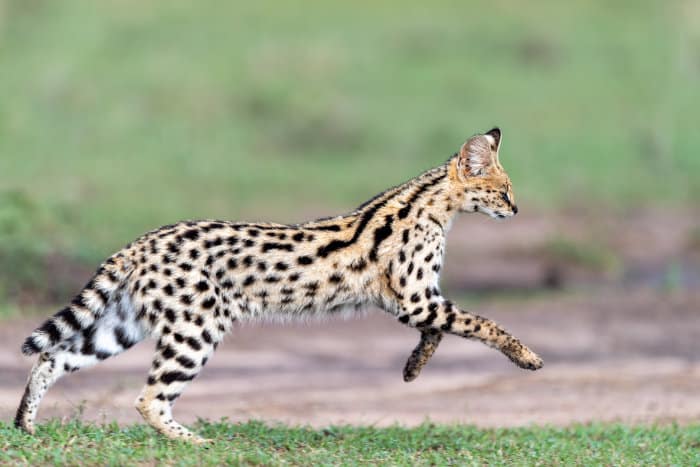
Caracals and servals are both renowned for their feats of athleticism. And like in many other areas, these fast felines are also closely matched when it comes to speed.
How fast is a caracal? Up to 80 km/h (50 mph) in short bursts. Caracals share hunting strategies with many of their relatives, sneaking up on their prey then snatching it after a short sprint.
Servals are just as speedy, sprinting at approximately 80 km/h as well. That’s roughly as fast as a lion!
Legendary leaping ability
Caracals don’t just have straight-line speed – they also boast a vertical jump that would make Michael Jordan jealous. These crafty cats can jump over three metres into the air, even batting birds out of the sky.
Servals are no slouches, either. The powerful predator can also jump almost three metres high, or pounce from several metres away onto unwitting prey.
Caracals and Servals as Pets
Throughout history, humans have desired beautiful and exotic animals. It’s no surprise, then, that many people want to own African wild cats as pets.
Can you have a caracal or serval as a pet? It depends.
Should you? Almost certainly not.
While these wild cats are related to the domestic cat, a popular pet worldwide, the clue is in the name: wild cats.
Servals and caracals may look cute, but they’re wild animals at heart. And not just any animals, but top predators. These wild cats may be tamed to an extent, but they’ll never take to captivity like a truly domesticated animal.
Pet servals and caracals can show affection, but they’re likely to get frustrated and destructive. And the neighbour’s chihuahua might just be in danger when your ‘pet’ gets peckish.
Aside from their suitability (or lack thereof) as pets, there’s the ethical angle. Why take these species from the wild when there are already so many breeds of domestic cat more suited to captivity?
If you’re dead set on owning a pet serval or caracal, you’d have to check the legality – they’re illegal to own in some countries, while others require a license.
Overall, it’s definitely a better idea to let these animals stay wild.
Caracal vs Serval: Who Would Win?
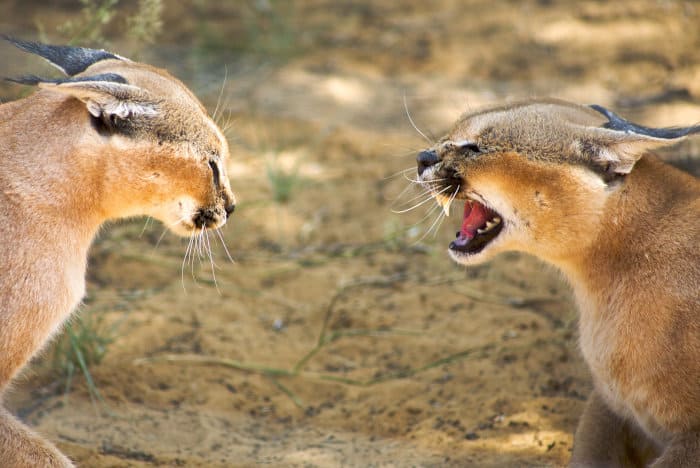
Caracal and serval territory sometimes overlaps, and the two might compete for some of the same food.
So, it’s plausible that a caracal vs serval showdown could occur.
Is it likely, though? Probably not. These are two shy and elusive species that would rather avoid conflict. Predators need to stay injury-free, so this would likely be a lose-lose scenario for both parties.
Indeed, it’s hard to find any evidence of serval and caracal spats. Hypothetically, perhaps the caracal would have a slight edge, as it’s marginally larger and takes down bigger prey on average.
Serval and caracal cats are more concerned with other carnivores than each other. Lions, leopards, and hyenas would all be more likely to attack and kill smaller predators in their territory.
Conservation Status
Are servals endangered? What about caracals?
The good news is that neither species is classified as endangered. Servals’ and caracals’ conservation status is Least Concern on the IUCN Red List.
That doesn’t mean it’s smooth sailing. Farmers and herders often kill these cats to protect their animals, though it’s rare for either cat – especially servals – to prey on livestock.
Servals are used in traditional medicine in parts of West Africa, and caracals are hunted for the pet trade in the Arabian Peninsula. Habitat loss threatens both species.
Caracal vs Serval: Two Amazing African Cats

The phrase “caracal vs serval” suggests these two African wild cats are adversaries. In reality, the two secretive species have many things in common.
Servals and caracals are wild animals in an unforgiving environment. They’re fighting for resources more so than they’re fighting each other – most of their energy goes towards simply surviving.
While they’re both beautiful animals, having a caracal or serval as a pet is an unwise idea. They were born to roam their territory freely – not to be a status symbol.
It’s far more rewarding – albeit difficult – to see these creatures in their natural environment. Head out on safari and you might be lucky enough to catch a glimpse of these wonderful wild cats.

